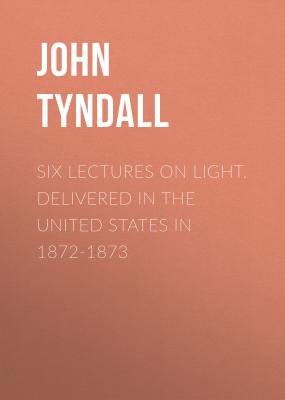Six Lectures on Light. Delivered In The United States In 1872-1873. John Tyndall
Читать онлайн.| Название | Six Lectures on Light. Delivered In The United States In 1872-1873 |
|---|---|
| Автор произведения | John Tyndall |
| Жанр | Физика |
| Серия | |
| Издательство | Физика |
| Год выпуска | 0 |
| isbn |
6
The low dispersive power of water masks, as Helmholtz has remarked, the imperfect achromatism of the eye. With the naked eye I can see a distant blue disk sharply defined, but not a red one. I can also see the lines which mark the upper and lower boundaries of a horizontally refracted spectrum sharp at the blue end, but ill-defined at the red end. Projecting a luminous disk upon a screen, and covering one semicircle of the aperture with a red and the other with a blue or green glass, the difference between the apparent sizes of the two semicircles is in my case, and in numerous other cases, extraordinary. Many persons, however, see the apparent sizes of the two semicircles reversed. If with a spectacle glass I correct the dispersion of the red light over the retina, then the blue ceases to give a sharply defined image. Thus examined, the departure of the eye from achromatism appears very gross indeed.
7
Both in foliage and in flowers there are striking differences of absorption. The copper beech and the green beech, for example, take in different rays. But the very growth of the tree is due to some of the rays thus taken in. Are the chemical rays, then, the same in the copper and the green beech? In two such flowers as the primrose and the violet, where the absorptions, to judge by the colours, are almost complementary, are the chemically active rays the same? The general relation of colour to chemical action is worthy of the application of the method by which Dr. Draper proved so conclusively the chemical potency of the yellow rays of the sun.
8
Young, Helmholtz, and Maxwell reduce all differences of hue to combinations in different proportions of three primary colours. It is demonstrable by experiment that from the red, green, and violet
Some years ago Sir Charles Wheatstone drew my attention to a work by Christian Ernst Wünsch, Leipzig 1792, in which the author announces the proposition that there are neither five nor seven, but only three simple colours in white light. Wünsch produced five spectra, with five prisms and five small apertures, and he mixed the colours first in pairs, and afterwards in other ways and proportions. His result is that red is a
9
The following charming extract, bearing upon this point, was discovered and written out for me by my deeply lamented friend Dr. Bence Jones, when Hon. Secretary to the Royal Institution:—
'In every kind of magnitude there is a degree or sort to which our sense is proportioned, the perception and knowledge of which is of the greatest use to mankind. The same is the groundwork of philosophy; for, though all sorts and degrees are equally the object of philosophical speculation, yet it is from those which are proportioned to sense that a philosopher must set out in his inquiries, ascending or descending afterwards as his pursuits may require. He does well indeed to take his views from many points of sight, and supply the defects of sense by a well-regulated imagination; nor is he to be confined by any limit in space or time; but, as his knowledge of Nature is founded on the observation of sensible things, he must begin with these, and must often return to them to examine his progress by them. Here is his secure hold: and as he sets out from thence, so if he likewise trace not often his steps backwards with caution, he will be in hazard of losing his way in the labyrinths of Nature.'—(
10
I do not wish to encumber the conception here with the details of the motion, but I may draw attention to the beautiful model of Prof. Lyman, wherein waves are shown to be produced by the
11
Copied from Weber's
